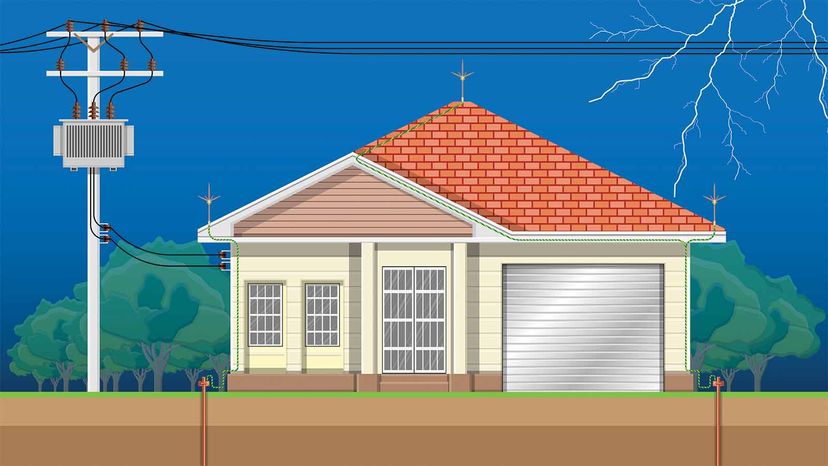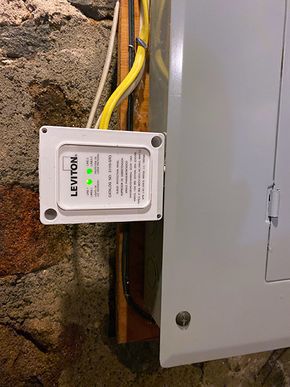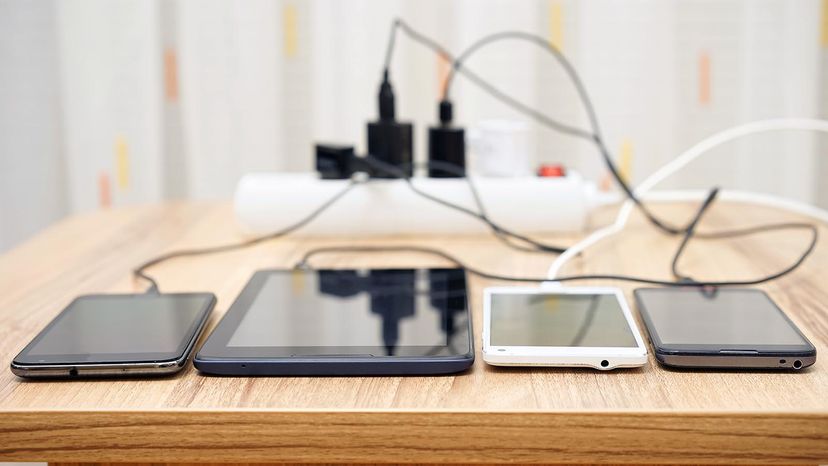 Many things can cause a major power surge in your home, including power transformers malfunctioning or substations going offline. Even lightning can sometimes cause a spike in voltage.
Many things can cause a major power surge in your home, including power transformers malfunctioning or substations going offline. Even lightning can sometimes cause a spike in voltage.
Just about every home contains electronic devices susceptible to power surges, including kitchen appliances, computers, media players and gaming consoles. Components inside these electronics demand a specific, steady voltage to run properly, so drastic changes in the flow of electricity can cause them to malfunction and potentially become damaged. Surges like these often occur during heavy thunderstorms or partial blackout scenarios.
A simple solution to prevent them is with a power strip surge protector. You probably even have some in use at your home. These create a stopgap between an electrical outlet and the devices that are plugged into them, regulating the incoming voltage.
Advertisement
However, these types of surge protectors can only provide protection to the electronics plugged into them. If you want to shield an entire home from voltage spikes, you may want to invest in a whole-house surge protector.
Contents
- What Is a Whole-house Surge Protector?
- What Devices are Vulnerable to Surges?
- Should You Install a Whole-house Surge Protector?
What Is a Whole-house Surge Protector?
 You’ll have to hire a licensed electrician to install a whole-house surge protector, which is attached to your home’s electrical panel.
You’ll have to hire a licensed electrician to install a whole-house surge protector, which is attached to your home’s electrical panel.
"Whole-home surge protection is mostly found in homes and buildings with sensitive electronics that you would want to prevent from being exposed to harmful power surges. If those types of facilities or properties went offline, it could cost them significant revenue and/or diminish the trust their clients have for their product," says Chris Haas, a licensed electrician in Maryland. "Some homes, such as those that may run a home-based enterprise or that have expensive electronics, can also install them."
A whole-house surge protector looks like a nondescript gray box and must be installed by an electrician. It is mounted between your home’s circuit breaker panel and the community power grid. Once activated, the protector regulates the flow of current to every electrical device throughout your house, including things like water heaters and air conditioning units.
Advertisement
"Whole-home surge protectors protect the entire home, including your hard-wired appliances and items you may not be able to install a surge strip on like your washer, dryer, fridge and furnace," Haas explains. "This provides the homeowner with much more protection on some of their most expensive appliances to repair or replace."
What Devices are Vulnerable to Surges?
 All of the electronics in your home are vulnerable to damage from a power surge.
All of the electronics in your home are vulnerable to damage from a power surge.
Almost anything plugged into the power grid can be affected by a voltage spike, but today’s modern electronics are particularly sensitive. "Anything with digital displays, circuit boards, computer boards or [components] that isn’t strictly mechanically operated is vulnerable to being damaged by a power surge," Haas says.
In the United States, most electronics are made to take in 120 volts of alternating current, although their power supplies will usually contain a converter to step the current down to a lower voltage of DC output. Spikes in current well beyond the 120 volt standard will cause extra wear on those power supplies, and potentially the components they give power to.
Advertisement
Small surges can happen within your home grid, when power intensive appliances like dryers and air conditioners switch on or off. Larger surges are often the result of power transformers malfunctioning or substations going offline. Rarely, lightning strikes can also enter electrical lines and cause massive spikes in voltage. In the most extreme cases, devices can overheat to the point of sparking an electrical fire.
If an appliance or piece of electronics in your home is hit with a power surge, you may not notice any problems right away. But repeated spikes can fry the connections on delicate circuit boards, leaving you with a non-functional device and a repair bill.
Home insurance may cover some costs associated with power surge damage, but preventing the cause will always result in less downtime. "The worst case for a power surge is having to file insurance claims to get your appliances repaired or replaced, including not having A/C on the hottest days of the summer," Haas says. "A surge protector grounds the surge and continues to protect your home, while your neighbors are faced with the worst case."
Advertisement
Should You Install a Whole-house Surge Protector?
 If this overloaded power strip looks familiar, you probably want to consider something designed to protect your entire house instead.
If this overloaded power strip looks familiar, you probably want to consider something designed to protect your entire house instead.
Whole-house surge protectors are commonly used in commercial and industrial settings, to cover thousands of dollars’ worth of electronics and machinery. However, they’re just as beneficial for homeowners.
"Today all your cooking equipment — your stove, microwave, dishwasher, Keurig, wall-mounted TVs — all need to be considered when thinking about vulnerability and protection," Haas says. "That’s just what a ‘regular home’ has that’s vulnerable. If you run a business or are involved with certain hobbies, you could have servers, multiple computers and gaming consoles, too."
Advertisement
Power strip surge protectors can cover things like computers and televisions, but appliances that are hardwired into the grid will be left unprotected. Haas recommends using both a whole-house surge protector and traditional outlet protectors to cast the widest possible safety net. Even with a protector at the circuit breaker box, voltage irregularities can still occur inside the house, so those additional power strips will smooth those out.
Whole-house protectors can also be surprisingly affordable, with many devices available for less than $100. Of course, there’s also the additional cost of hiring that electrician to do the installation. "Whole-home surge protection can vary from a few hundred dollars for your electrician to provide and install one, to over a thousand if you want the top products on the market," Haas says. "All things considered, they’re one of the cheaper improvements you can make for your home’s electrical system."
Now That’s Interesting
The 120-volt standard of U.S. power lines is actually more of a range of operation. Power outputs along the grid can vary anywhere from 110 to 169 volts of alternating current and still be considered within the standard. Power hungry appliances like dryers and heat pumps require their own dedicated 240V lines to function.
Advertisement




